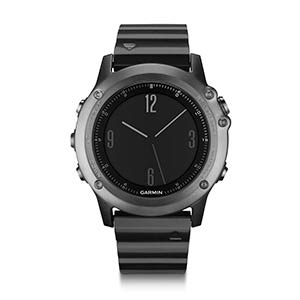
|
|
|||||||
|
Home > Gadget Reviews > Garmin Fenix 3
Garmin Fenix 3 Sapphire GPS Multisport Watch
What's Hot: Full featured multisport watch in a luxury watch design. Impressive battery life. What's Not: May be too big/heavy for some. No support (yet) for swim workouts.
Reviewed June 11, 2015 by Tom Slayton, Staff Writer
|
|||||
|
Garmin's new GPS enabled multisport Fenix 3 caused a bit of a stir when it hit the market so soon after their excellent 920XT. Was it intended to replace the 920XT? If not, why do the two overlap on so many features and functions? The short answer is "no." The Fenix 3 is not a replacement for the 920XT. It's bigger, heavier, is missing the 920XT's front-facing buttons, and is more expensive. While it does include theoretical support for swim workouts (more on this later) a digital compass, a GPS-assisted altimeter (920XT includes barometric altimeter, only), a higher resolution screen, and a thermometer; none of these features are really enough to set it apart from the 920XT, so why sell both? Apparently, it just comes down to style and personal preference. For example, I like large, classically styled watches so the Fenix 3 feels/looks good on my arm all day long. My wife, however, is positively overpowered by the Fenix 3 while wearing it, yet looks like a badass wearing the chunky 920XT because it's obviously a training watch; one she wears proudly like the hard-earned badge of honor that it is. With that inevitable comparison out of the way, on with the review. Although I regularly exercise with some intensity, I have never owned a multisport watch because I have never found one that included strong support for swimming and met my quirky and entirely subjective aesthetic needs. First, I like metal watches/watchbands and round watch faces. Second, I really like sapphire watch crystals. When I saw the Fenix 3 I was intrigued; but when I saw the Fenix 3 Sapphire, I thought: "now, here's a watch that could win my heart." The Sapphire edition is $100 more than the regular Fenix 3, but it includes an ion-plated metal bracelet that matches the finish on the watch face and a sapphire crystal. Considering the metal band alone would cost you $129 direct from Garmin, this seemed like a pretty good deal to me. While explaining ion-plating (also known as physical vapor deposition) is beyond the scope of this review, I can tell you that it's not paint, and won't chip, peel, or flake; in fact, it won't scratch any easier than the metal to which it is deposited.
The Fenix 3 in red and the Fenix 3 Sapphire I'm no longer a cyclist but I swim and run with great regularity, and I have been extremely pleased with the Fenix 3's features and function. For running, it couldn't be easier; just select the type of run from the menu, wait for the watch to acquire a strong GPS signal (usually much less than a minute), and off you go. For both running and cycling, the Fenix 3 will track all relevant data such as distance, duration, average pace, best times, etc., and will even allow you to download training plans and workouts from Garmin. If you choose to use a heart rate monitor (sold separately), it will also provide you with an estimate of your max VO2, which is the single-best measure of cardiovascular fitness. If you don't mind messing with these things, the data they provide are invaluable. The Fenix 3 also has a feature that keeps track of your route so you can be sure to come back the same way. Although there is no map overlay, it would become immediately obvious if you deviated on your return trip thanks to the watch displaying both your original route and your current position in relation to that route. If you've ever hiked without trails, you know how useful this is. Swimming, of course, is a completely different animal, which is why it is often minimally supported in multisport watches or overlooked altogether. Fortunately, the Fenix 3 performs exceptionally well in this regard, both in pool and open water swims. Open water swims use GPS but Pool swims do not. Instead, you tell the Fenix 3 how big your pool is (25 yards, 50 meters, etc) and the watch will use its accelerometer to figure out what stroke you are doing, and for how many lengths. It successfully identified all 4 strokes every time, and never missed a length. It does, however, get badly confused during kick sets because your arms don't move for them. Thankfully, Garmin includes a drill mode that will allow you to track these yards manually. Once accessed, this mode will keep track of the duration of the set. Once complete, simply tell it how far you went via a scrolling menu, and then return to your regular workout. If you go to the trouble to press the lap button after each interval, the Fenix 3 will provide you with very rich data regarding speed, distance/stroke, and SWOLF. Since I usually only have a few seconds between intervals, I normally only use the lap button at the end of each set. According to Garmin, unlike the 920XT, the Fenix 3 supports swim workouts. Remember that heart rate monitors do not work underwater (except for optical HRM, which is disabled by the Fenix 3 in pool but is enabled for open water) so if you own one, don't take it swimming. Unfortunately, at the time of this writing, this feature does not appear to be live, which is quite a disappointment. To me, the holy grail of swim watch features would be the ability to set up different sets of intervals (10 x 100 free with a 1:30 interval, for example) and have the watch vibrate each time when its time to push-off. Link 4-5 sets like this together, and you would have a completely scripted workout that wouldn't require you to keep track of anything. I can't tell you how many times my mind has wandered during an interval causing me to forget how many I'd completed. |
Deals and Shopping:
Advertisement |
||||
|


